Email marketing is still one of the best marketing tools for online store owners. Not only is it the cheapest, but it allows you to segment your targeting, build repeat brand awareness, is easy to manage and create, and offers great ROIs (return on investment). Don’t believe me? Here are some email marketing stats to prove it:
- By 2019, a whopping 2.9 billion email users are expected
- 73% of millennials prefer email for business communication
- Over 100 billion emails are sent each day
- 28% of consumers would like to receive promotional emails more than once per week
So what is the trick to not only building your mailing list, but leveraging it to bring in good traffic and lots of sales? The answer lies in the metrics: metrics that point to whether you’re on your way to success or missing out on a lot of possible sales.
Bonus Content: A Full Guide to Email Marketing Platforms
Here are the 5 email marketing metrics you need to monitor for maximum email marketing business success.
Email Marketing Metric 1: CTR (Click-Through Rate)
The most coveted email marketing metric of all is the click-through rate. The reason is pretty self-explanatory: the more people follow your CTA (call-to-action) and click through to the site, the more traffic your email marketing is bringing, and the bigger the chance of conversions you have. CTRs will give you insight into how each email has performed in getting people to actually click through to your store.
No matter which email marketing platform you’re using, you’re guaranteed to find your CTR on every email you have sent out. In general, according to a Hubspot case study, small businesses with up to 10 employees max should be getting a median click rate of 6.9% CTR. However, your median should be determined by comparing your previous emails as well as by the industry you’re selling in. Here are industry standards according to leading email marketing platform MailChimp.
| Industry | Open | Click |
| Agriculture and Food Services | 24.71% | 2.98% |
| Architecture and Construction | 24.78% | 2.90% |
| Arts and Artists | 27.23% | 2.85% |
| Beauty and Personal Care | 18.48% | 1.96% |
| Business and Finance | 20.97% | 2.73% |
| Computers and Electronics | 20.87% | 2.16% |
| Construction | 22.10% | 1.95% |
| Consulting | 19.54% | 2.26% |
| Creative Services/Agency | 22.41% | 2.61% |
| Daily Deals/E-Coupons | 15.22% | 2.39% |
| E-commerce | 16.75% | 2.32% |
| Education and Training | 22.00% | 2.63% |
| Entertainment and Events | 21.21% | 2.33% |
| Gambling | 18.75% | 3.35% |
| Games | 20.82% | 3.33% |
| Government | 26.33% | 3.62% |
| Health and Fitness | 21.93% | 2.57% |
| Hobbies | 28.46% | 5.13% |
| Home and Garden | 23.82% | 3.47% |
| Insurance | 21.56% | 2.11% |
| Legal | 22.49% | 2.99% |
| Manufacturing | 21.74% | 2.33% |
| Marketing and Advertising | 17.81% | 1.92% |
| Media and Publishing | 22.14% | 4.70% |
| Medical, Dental, and Healthcare | 22.43% | 2.42% |
| Mobile | 19.43% | 2.10% |
| Music and Musicians | 22.86% | 2.84% |
| Non-Profit | 24.98% | 2.76% |
| Other | 23.06% | 2.81% |
| Pharmaceuticals | 20.02% | 2.51% |
| Photo and Video | 25.36% | 3.49% |
| Politics | 22.23% | 2.17% |
| Professional Services | 20.89% | 2.47% |
| Public Relations | 20.12% | 1.64% |
| Real Estate | 20.84% | 1.91% |
| Recruitment and Staffing | 20.73% | 2.18% |
| Religion | 26.46% | 3.11% |
| Restaurant | 21.17% | 1.25% |
| Restaurant and Venue | 21.71% | 1.33% |
| Retail | 20.96% | 2.50% |
| Social Networks and Online Communities | 21.71% | 3.33% |
| Software and Web App | 20.95% | 2.29% |
| Sports | 25.41% | 3.19% |
| Telecommunications | 21.57% | 2.43% |
| Travel and Transportation | 20.69% | 2.17% |
| Vitamin Supplements | 17.26% | 1.80% |
How to Improve Email Marketing CTR Rates
If you are continuously getting below-average CTRs then you will need to ask yourself these questions:
- Is the email content relevant to the interests of your target audience?
- Did you add too much value to the email body, which enabled subscribers to skip the click-through to get the full story?
- You are not segmenting your emails and sending one for everyone (Did you know Click-throughs are 100.95% higher in segmented email campaigns?)
- Was your CTA strong enough and did it match the subject of your email?
The third point is an important one. Too often we try too hard to entice our subjects without pointing to the content, which could result in a subscriber clicking into the email only to find that the subject and content don’t add up. They are then more likely to feel ‘duped’ and therefore less likely to follow through with a click.
Email Marketing Metric 2: Unsubscribe Rate
This email marketing rate is the most soul-crushing for anyone putting effort into email marketing. The truth is, unsubscribes come with email marketing territory, but the percentage of how much tells you volumes. Online retailers should expect an unsubscribe rate of around 0.12% according to studies, which means anything above that is a point for concern for automated emails or newsletter blasts. There are a number of reasons why your unsubscribe rates are high – these include the following top reasons:
- You’re Always Trying to Sell: Emails need to consistently give value. If your emails are always about getting their money, this could deter them. Instead, mix it up by including your blog content or useful niche information.
- You’re Sending Too Many Emails: Are you sending ‘last-minute’ deals four times a week? Chances are people will start to think something is fishy. Instead, mix up your content to include new arrivals, seasonal sales, tips, etc., and don’t send more than one to two emails per week unless your stats show you otherwise.
Other reasons could include that your email look unprofessional, you’re emailing too often, that your content isn’t relevant to your subscribers, that they never signed up, or didn’t realize they signed up for your email list. So if your unsubscribe metrics are high, A/B test different content and frequency and make sure that the products you offer in competitions line up with your target audience and are not general products everyone would want.
Cost-Cutting Tip: If you’re paying for number of subscribers, make sure that those people who have been taken off the list aren’t in your mailing list of subscribers. Whether they receive your emails or not, having their mail on the list still counts as a subscriber.
Email Marketing Metric 3: Email Subscribers Conversion Rate
This next metric is super important because you can have the best email strategy ever, but if you don’t have email addresses to send them to, it’s a moot point. What you are looking at with your email subscribers conversion rate is the number of email subscribers you get versus the amount of traffic you have. Say that for every 100 online store visitors you get, two people opt-in or subscribe to your email list. That would give you an opt-in rate of 2%, which is right on the average mark and the medium you should be looking for, with the ultimate goal to get that number to well above the average of 5%.
To do this, you first need to track this. You can do that by checking your Google Analytics and comparing the number of page visitors to the number of new subscribers you have within the same amount of time to get your percentage. If your number is 2% or lower, here are the main causes for poor email subscribers conversion rates:
- You’re not offering anything in exchange for those email addresses or if you are, it may not be appealing to your audience
- You’re targeting the wrong audience with your email opt-in ads
- You don’t have the right mechanisms in place to offer email opt-ins
Pro Tip: Turn Unsubscribes into Learning
Unsubscribes, if handled correctly, can not only give you valuable information to improve these rates, but keep your brand impression in tact. Keep your copy polite and to the point, and keep the process as streamlined as possible – there is nothing worse for a user who is trying to get off a list than when the site makes them jump through hoops (or landing pages) to do it. Ensuring your unsubscribe button is easy to find will also help with this in a big way.
Video: 3 Tips to Reduce Email Unsubscribes
Email Marketing Metric 4: Unconfirmed Opt-In Rate
Email opt-in, or email subscription rate as discussed above, refers to the percentage of site visitors who actively subscribe to your email lists. The average email opt-in rate is around 1.95%, but on average only about 50% of your 1.95% will then finish subscription and opt-in to your email, which results in you paying for subscribers who are not going to see your emails.
So what is your unconfirmed opt-in rate telling you?
If the percentages decrease or maintain low, you’re on track. If the percentage increases, it could mean that your confirmation emails are landing in spam folders. Emails land in spam for a number of reasons; here are the top causes that could be to blame:
- Your subject line is spammy
- Your description isn’t brief, to the point and clear
- Your ‘Subscribe’ button isn’t visually clear
- Your low open rates are putting you at a higher risk of being flagged as spam
- You used spam trigger words
If it’s not because of spam, then it’s because of users. Perhaps your email wasn’t clear enough and the user wasn’t sure what the next step was or understood that it is mandatory for them to do so to apply for those opt-in perks.
Email Marketing Metric 5: Open Rate
Last, but not least, the email marketing open rate metric. As I mentioned in the intro, over 100 billion emails are sent every day, which means your emails are competing for attention in a BIG way. I receive around 50 emails a day, and believe me when I tell you that I only keep the ones I intend to open – the rest go in the trash.
The average open rate for small to medium businesses – up to 10 employees – is around 21% generally, and 16.75% for eCommerce. However, that doesn’t mean you should try for a higher average. Say you have a lower open rate, but a high click rate, then you can deduce that the content of your mail is good. Therefore, by increasing your open rate, you will increase your clicks and, ultimately, your sales.
Open rate is not a difficult metric to track and is provided by all email platforms. What you will want to do is watch your open rate per email over the next couple of emails to get an average of where you are. If that number is less than average, chances are:
- You may be using your business name instead of a personal name
- Your subject lines suck
- Your subject lines land you in the spam folder
So what to do? Here are the top four things you can try (A/B test) to get those open rates up!
1. Segment, Segment, Segment!
Marketing rule number 1: One size does not fit all, and email marketing is no different. Segment your email marketing lists into purchase history groups such as potential shoppers, past shoppers, or by demographics such a location or income to ensure the right content is going to the right people.
2. A/B Subject Lines
Subject lines can make or break your mailing list and testing lines can go a long way to increasing open rates. Most email marketing platforms let you A/B test subjects while you’re sending mails. Meaning, it will send two different subjects to a certain group of your subscribers and then automatically choose the highest performer for your complete list.
Need help with subject line text? Visit our 9 Proven Tips for the Best Email Subject Lines post for more.
3. Avoid Spam Triggers
General spam triggers – such as writing in all caps, or words such as ‘free’ or ‘deal’ – can send your emails straight to your subscribers’ spam folder. However, it is important to note that it all depends on how your subject relates to the content of your email. Using these trigger words as ‘click-bait’ without it matching the content of what you’re offering will spell spam folder disaster.
4. Get Personal
Have you tried using your own name instead of your online store’s when sending an email? Seeing an unfamiliar brand name in one’s inbox screams, “Advertising.” But at the same time, seeing any old person’s name instead of a familiar brand name could cause the opposite. The trick is to test them both, or even try using a combination such as “Name from Brand” to see which positively affects your open rate.
Pro Tip: Bounce Rate
If you continuously get good open rates and have a sudden drop with one blast, then, before you panic, check your bounce rate. A much higher than usual bounce rate for that same blast could mean a mail server problem.
The Bottom Line
The bottom line is this: these 5 metrics together will show you if you’re on point with your email marketing. It will also give you your ROIs, allowing you to compare the success of your email campaigns versus the time and money you are spending on them, as well as point to issues on your site that you need to address.
What do I mean? If your CTR, unsubscribe, opt-in, unconfirmed and open rates are all above average, it means it is driving good traffic. If that traffic is not buying, then your conversion rates could be suffering because the content you have them clicking to isn’t relevant, your site isn’t user-friendly, or doesn’t match the promise of the email. If you’re looking for more online store feedback, check out our The Online Store Feedback You Need to Hear post.
Have something to add? Post your comments below!

Nicole is a content writer with over sixteen years experience and flair for storytelling. She runs on a healthy dose of caffeine and enthusiasm. When she's not researching the next content trend or creating business content strategies, she's an avid beachgoer, coffee shop junkie and hangs out on LinkedIn.
Recommended articles
 Facebook Ads for eCommerce: 16 Strategies, Examples & Tips
Facebook Ads for eCommerce: 16 Strategies, Examples & Tips
 How to Build a Winning eCommerce Ads Strategy
How to Build a Winning eCommerce Ads Strategy
 Google Ads for eCommerce: Everything You Need to Know
Google Ads for eCommerce: Everything You Need to Know
 10X Your Traffic with PPC Management Software
10X Your Traffic with PPC Management Software
Comments
Powered by Facebook Comments






